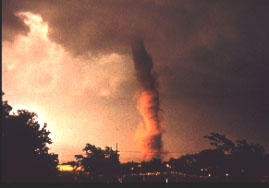Types of Fluid Flow
Fluid flow is generally broken down into two different types of flows, laminar flow and turbulent flow. Laminar flow is fluid motion in which all the particles in the fluid are moving in a straight line. For example, the thin layer of fluid in contact with the wall of a pipe travels very slowly due to the friction at the wall. Moving toward the center of the pipe, the fluid travels in layers of increasing speed, reaching the maximum speed at the center of the pipe. These layers slide past one another with little interaction. When the speed of the fluid in relation to the pipe reaches and passes a critical speed, the fluid motion becomes turbulent. Turbulent flow is an irregular flow of particles; characterized by whirlpool-like regions. Unlike the straight line motion of laminar flow, the particles of turbulent flow are in a state of chaos, some actually with opposite velocity vectors to each other. Both types of flow occur inside an object or outside an object, for example, fluid flow inside a pipe or fluid flow around a baseball.
A.) B.)
B.) 
http://members.tripod.com/~del_jones/f1_tn.htm
A.) Laminar Flow(no eddies)
B.) Turbulent Flow
A basic understanding of laminar flow will help the understanding of turbulent flow. A laminar flow is one in which all the particles of a fluid within a layer are moving at the same rate. Another way to think of this is by visualizing cars moving smoothly along a multi-lane road; everything is orderly, under control, with the fast cars in the left lane and slow cars in the right lane. In fluid flow, the fluid in contact with an objects surface will slow, however the particles within a layer will all still be traveling close to a consistent velocity. When the critical speed of a fluid is reached the fluid becomes turbulent. The point at which a fluid becomes turbulent is based on a unit less parameter called the Reynolds number.

http://www-personal.engin.umich.edu/~dkyser/weather/pics.htm